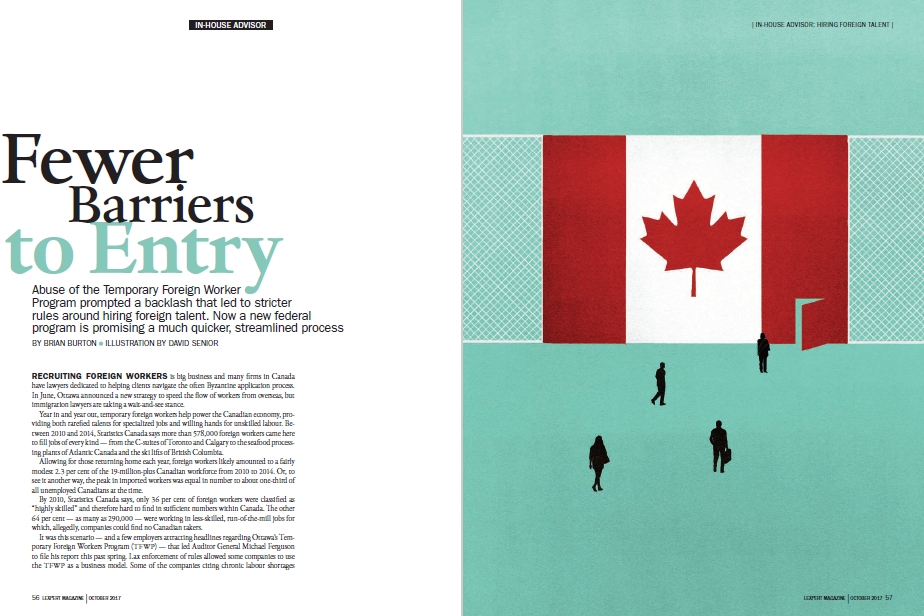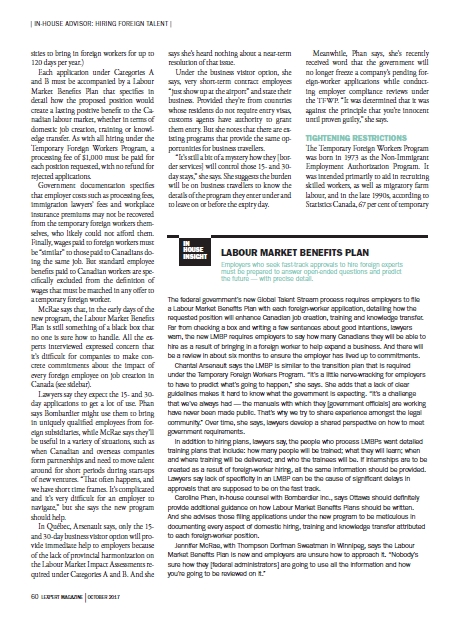 RECRUITING FOREIGN WORKERS IS big business and many firms in Canada have lawyers dedicated to helping clients navigate the often Byzantine application process. In June, Ottawa announced a new strategy to speed the flow of workers from overseas, but immigration lawyers are taking a wait-and-see stance.
RECRUITING FOREIGN WORKERS IS big business and many firms in Canada have lawyers dedicated to helping clients navigate the often Byzantine application process. In June, Ottawa announced a new strategy to speed the flow of workers from overseas, but immigration lawyers are taking a wait-and-see stance.
Year in and year out, temporary foreign workers help power the Canadian economy, providing both rarefied talents for specialized jobs and willing hands for unskilled labour. Between 2010 and 2014, Statistics Canada says more than 578,000 foreign workers came here to fill jobs of every kind — from the C-suites of Toronto and Calgary to the seafood processing plants of Atlantic Canada and the ski lifts of British Columbia.
Allowing for those returning home each year, foreign workers likely amounted to a fairly modest 2.3 per cent of the 19-million-plus Canadian workforce from 2010 to 2014. Or, to see it another way, the peak in imported workers was equal in number to about one-third of all unemployed Canadians at the time.
By 2010, Statistics Canada says, only 36 per cent of foreign workers were classified as “highly skilled” and therefore hard to find in sufficient numbers within Canada. The other 64 per cent — as many as 290,000 — were working in less-skilled, run-of-the-mill jobs for which, allegedly, companies could find no Canadian takers.
It was this scenario — and a few employers attracting headlines regarding Ottawa’s Temporary Foreign Workers Program (TFWP) — that led Auditor General Michael Ferguson to file his report this past spring. Lax enforcement of rules allowed some companies to use the TFWP as a business model. Some of the companies citing chronic labour shortages were more likely hiring foreigners to overcome domestic retention problems. “In our opinion, this type of situation appeared to be a retention problem and not a labour shortage problem. ... These findings matter because … Canadians expect the [government] to manage the program in a way that makes sure the [TFWP] is used to respond to real Canadian labour shortages.”
GLOBAL SKILLS STRATEGY
Business immigration lawyers, meanwhile, emphasize that highly specialized foreign workers, provide essential skills and help the economy grow, ultimately creating more jobs for Canadians. Abusers of the system are few, but provoke dramatic headlines while obscuring the value of the Temporary Foreign Workers Program to the Canadian economy. Some even suggest that sensitivity to headlines has led to more layers of unreasonable processing.
Lawyers who spend their days trying to make the system work for their corporate clients say the federal government’s newly announced Global Skills Strategy, designed to fast-track approvals for the most highly skilled, highly-paid positions, is a welcome step on the road back to accessible foreign talent.
Ottawa has pledged to reduce wait times to 10 working days each for Labour Market Impact Assessments (LMIAs) and another 10 days for the work permits that are processed only after favourable LMIAs have been received. But business immigration lawyers say time will tell whether the government can meet its own 10-plus-10-day processing targets.
Read more: What does an immigration lawyer do to help businesses?
Caroline Phan, in-house counsel and global manager of trans-border recruitment for Montréal-based Bombardier Inc., says the global train and plane manufacturer only uses the TFWP when local recruiting and inter-company transfers have not found the necessary skills. At any one time, she estimates Bombardier counts about 300 foreign workers in its Canadian work force of about 17,000 people. She says her employer is looking at using the new program, in particular for bringing in top-level technology specialists. But in Québec, she says, 10-day LMIA processing is not yet a reality. The federal Labour Market Impact Assessment is combined with provincial documentation, and the two levels of government have not yet agreed on a harmonized process.
Phan says Canadian employers should be aware that the Canadian process is “easier than in other countries [and] Canadian authorities made a lot of efforts to improve the program,” accommodating employers while protecting the Canadian labour market from potential abuse.
Chantal Arsenault, a business immigration specialist with Norton Rose Fulbright Canada LLP in Montréal, says the new Global Skills Strategy is “certainly an indication that employers are being heard” and that “everyone wants it to be successful.” But she says immigration lawyers have heard 10-day promises in the past. “There was already a 10-day process. I say that with a little bit of a smile because the 10-day period starts when they say it starts,” Arsenault says. “It starts when they open the application. I’ve seen cases where it was more than two weeks before the 10 days started.”
One seasoned business immigration lawyer calls the new Global Skills commitment to 10-day approvals for certain high-skill, very short-term positions “absolutely brilliant.” But he says the approval process and the employer compliance review system are still far too rigidly administered.
“Global Skills does nothing to address that,” he says. “The Labour Market Impact Assessment is still there.” But he adds, “The current government is likely headed in the right direction, especially if it addresses the unduly harsh enforcement regime set up under the former government. “Humanize it,” he urges. “Allow officers to exercise discretion and use common sense.”
Jennifer McRae, a business immigration lawyer with Thompson Dorfman Sweatman LLP in Winnipeg, agrees there was a definite “clampdown” on foreign-worker approvals after 2011 “due to a noticeable abuse of the Temporary Foreign Worker Program.” Employer compliance reviews, which were previously almost unknown, were imposed randomly on one-in-four foreign-worker applications. Reviews included time-consuming examinations of an employer’s performance under previous TFWP applications, and pending applications were routinely placed on hold until reviews were completed, McRae says.
“You could be looking at months,” she says. Lawyers agree that a four-month wait was fairly standard and seven months was not unknown, “during which time that rare and special talent went elsewhere,” McRae says. “Canadian employers were losing these people because of the long wait periods, and something had to be done.”
A NEW STRATEGY
Ottawa’s announced Global Skills Strategy was grafted to the Temporary Foreign Workers Program. The new strategy includes a $7.8-million, two-year Global Talent Stream pilot project, under which companies can apply for expedited processing of highly skilled foreign workers for positions of any duration specified by the prospective employer.
High-growth companies that need to hire uniquely talented foreigners to aid in growth-related projects can now apply under Category A of the Global Talent Stream, as long as the project results in additional Canadian jobs or some kind of knowledge transfer. Qualifying foreign workers would possess: advanced knowledge; experience or advanced degrees; and earn $80,000 per year or more. Category A remains subject to the long-standing TFWP requirement that jobs be advertised in Canada for a month before a foreign-worker application is filed.
No Canadian advertising is required prior to applying under Category B, through which any company can hire foreigners whose occupations are classified as in very short supply. The current list of qualifying occupations is entirely related to digital technologies and includes: computer systems managers, engineers, systems analysts and consultants; database analysts and administrators; software engineers and designers, and various others.
The new program sets no time limit on the stay of Category A and B temporary foreign workers in Canada, but application forms require the prospective employer to estimate the duration of the employment and provide some rationale for the requested timeframe.
A third option will allow employers to bring in high-value foreign specialists on very short contracts of 15 days over six months, or 30 days per year. Work permits are not required for these employees, who are viewed as “business visitors.” (An academic variant of this option allows universities to bring in foreign workers for up to 120 days per year.)
Each application under Categories A and B must be accompanied by a Labour Market Benefits Plan that specifies in detail how the proposed position would create a lasting positive benefit to the Canadian labour market, whether in terms of domestic job creation, training or knowledge transfer. As with all hiring under the Temporary Foreign Workers Program, a processing fee of $1,000 must be paid for each position requested, with no refund for rejected applications.
Government documentation specifies that employer costs such as processing fees, immigration lawyers’ fees and workplace insurance premiums may not be recovered from the temporary foreign workers themselves, who likely could not afford them. Finally, wages paid to foreign workers must be “similar” to those paid to Canadians doing the same job. But standard employee benefits paid to Canadian workers are specifically excluded from the definition of wages that must be matched in any offer to a temporary foreign worker.
McRae says that, in the early days of the new program, the Labour Market Benefits Plan is still something of a black box that no one is sure how to handle. All the experts interviewed expressed concern that it’s difficult for companies to make concrete commitments about the impact of every foreign employee on job creation in Canada (see sidebar).
Lawyers say they expect the 15- and 30-day applications to get a lot of use. Phan says Bombardier might use them to bring in uniquely qualified employees from foreign subsidiaries, while McRae says they’ll be useful in a variety of situations, such as when Canadian and overseas companies form partnerships and need to move talent around for short periods during start-ups of new ventures. “That often happens, and we have short time frames. It’s complicated and it’s very difficult for an employer to navigate,” but she says the new program should help.
In Québec, Arsenault says, only the 15- and 30-day business visitor option will provide immediate help to employers because of the lack of provincial harmonization on the Labour Market Impact Assessments required under Categories A and B. And she says she’s heard nothing about a near-term resolution of that issue.
Under the business visitor option, she says, very short-term contract employees “just show up at the airport” and state their business. Provided they’re from countries whose residents do not require entry visas, customs agents have authority to grant them entry. But she notes that there are existing programs that provide the same opportunities for business travellers.
“It’s still a bit of a mystery how they [border services] will control those 15- and 30-day stays,” she says. She suggests the burden will be on business travellers to know the details of the program they enter under and to leave on or before the expiry day.
Meanwhile, Phan says, she’s recently received word that the government will no longer freeze a company’s pending foreign-worker applications while conducting employer compliance reviews under the TFWP. “It was determined that it was against the principle that you’re innocent until proven guilty,” she says.

SIDEBAR: Labour Market Benefits Plan
Employers who seek fast-track approvals to hire foreign experts must be prepared to answer open-ended questions and predict the future — with precise detail.
TIGHTENING RESTRICTIONS
The Temporary Foreign Workers Program was born in 1973 as the Non-Immigrant Employment Authorization Program. It was intended primarily to aid in recruiting skilled workers, as well as migratory farm labour, and in the late 1990s, according to Statistics Canada, 67 per cent of temporary foreign workers were employed in skilled positions. But the Liberal government, under Prime Minister Jean Chrétien, expanded provisions for unskilled labour in 2002, when 91,270 applications were approved.
In 2007, the Conservative government under Prime Minister Stephen Harper increased TFWP funding by $30 million per year in an effort to speed application processing, and in 2008 a record 204,783 applications were approved, driven in large part by Oil Sands expansions and construction for the Vancouver Winter Olympic Games. But in her 2009 report, Auditor General Sheila Fraser said lack of oversight left workers vulnerable to abuse and gave the government no clear idea whether employers met the terms and conditions of their approvals.
She noted that the program was driven entirely by employer applications, with no target levels or limits on numbers of workers admitted. By 2010, according to Statistics Canada, nearly two-thirds of temporary foreign workers were classified as unskilled, by which time church groups and others were making headlines protesting substandard wages and working conditions of unskilled foreign workers.
With criticisms mounting, in 2011 the Harper government made Labour Market Impact Assessments more rigorous, sharply increased the frequency of employer compliance reviews and introduced the “four-in/four-out” rule. The rule allowed foreign temps to stay in Canada for up to four years but then required them to leave the country for four years before becoming eligible for re-entry. The change frustrated employees and employers because it gave outstanding workers little or no way to transition to permanent status in Canada.
Arsenault says there was a public perception that arose during this time that the Temporary Foreign Workers Program was all about acquiring “cheap labour” and that it undermined Canadian wage levels. “It’s not a question of cheap labour,” she explains. “It’s costly and time consuming to hire a foreign worker. They don’t do that when they have a candidate in Canada who could do the job.”
Despite tightening restrictions, the TFWP continued to draw unflattering headlines. In 2014, Federal Employment Minister Jason Kenney announced a moratorium on the food services industry’s use of the controversial program in view of “a significant number of allegations of abuse of the program, some of which appear to be quite flagrant, which were very disturbing to me,” he said.
Also in 2014, the federal government placed a cap of 30 per cent foreign workers in the workforce at any one location, moved that to 20 per cent in 2015 and 10 per cent in 2016. The government also increased application-processing fees from $275 per worker to $1,000. After Prime Minister Justin Trudeau won the 2015 federal election, the government fixed the cap on foreign workers at 20 per cent in any one location and killed the four-in/four-out rule that limits foreign hires. But it retained the $1,000-per-person processing fee.




